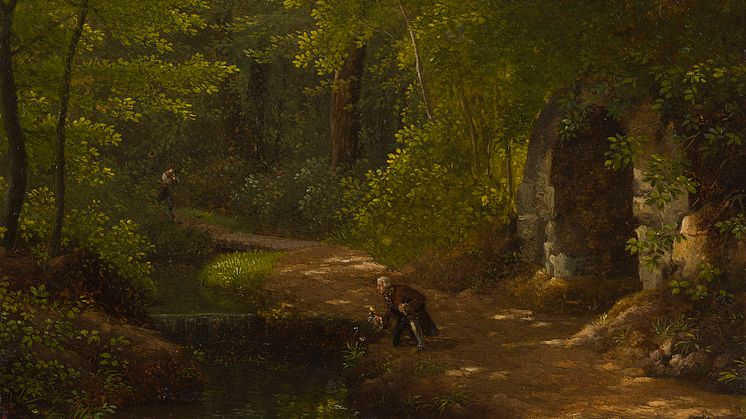
Press release -
Nationalmuseum acquires three French garden views
Nationalmuseum has acquired three views of French gardens and parks painted in the latter half of the 18th century byLouis-Gabriel Moreau and Alexandre Dunouy. Building on the proud tradition of topographical depictions in 17th-century French art, these artists catered to the early Romantic penchant for dense foliage and picturesque dilapidation. The park at Ermenonville features in two of the paintings, one of which shows the philosopher Jean-Jacques Rousseau picking flowers.
One of Rousseau’s disciples was Marquis René-Louis de Girardin, who in 1766 began constructing a landscaped park on his estate at Ermenonville, 40 km northeast of Paris. For the marquis, landscape gardening represented a blend of art and poetry, where drawings or paintings served as patterns for creating scenic variety. For this purpose, he seems to have engaged the services of Hubert Robert, the noted painter of ruins. In the summer of 1778, as the park at Ermenonville was nearing completion, Rousseau came to visit. As fate would have it, the famous philosopher died there just three weeks later. His pupil and patron, Marquis de Girardin, seized the opportunity and arranged for Rousseau to be buried on a poplar-covered island in a sarcophagus designed by Hubert Robert. Rousseau soon became a cult figure, and many admirers made the pilgrimage to his grave, including King Gustav III of Sweden. The philosopher lay at rest in Ermenonville until France’s new republican rulers had his remains transferred to the Panthéon in Paris in 1794. Among those who sought to profit from Rousseau’s tremendous popularity was the landscape painter Alexandre Dunouy (1757–1841). One of Nationalmuseum’s two recently acquired paintings by Dunouy is an anecdotal image of the philosopher picking flowers near the Banc des vieillards in the park, which is believed to have been painted around 1800.
The second of the acquired views of Ermenonville by Dunouy depicts a spot known as la Fontaine de Bocage, a woodland grove in the section of park north of the chateau. As the painting shows, the grove was traversed by a stream, and by a small waterfall the marquis had erected an altar with a love poem by Petrarch. In Dunouy's composition, we can see a woman resting in deep contemplation beside this diminutive monument. Despite the small scale, both here and in the image of Rousseau, the artist has managed to capture all the small details without being overly finicky. He reproduces the play of light in the branches and the reflections in the water surface using finely tuned colour values and a number of coloristic accents.
Slightly older than Dunouy, Louis-Gabriel Moreau the elder (1740–1806) had specialised much earlier in painting views, especially of gardens and parks in Paris and the surrounding area. He was a pupil of another of the city’s more prominent topographical artists, Pierre-Antoine Demachy. They soon realised there was a market for motifs of this kind, either as small, delicate images on snuff boxes or as cabinet paintings. But commercially viable motifs were not a given route to election to the French academy of fine arts. Moreau made two attempts to be elected, in 1787 and 1788, but was unsuccessful because the members considered his motifs too trivial. However, he found greater favour with one of the king’s brothers, the Count of Artois, who appointed Moreau as his court painter.
Unsurprisingly, Moreau drew many of his motifs from the old royal pleasure gardens and parks, several of which were in a state of picturesque dilapidation by the late 18th century. One such place was the baroque garden at Saint-Cloud near Paris, which provides the motif for the third of Nationalmuseum’s recent acquisitions. Another version by Moreau can be found in the Louvre, likewise depicting the majestic trees in this pleasure garden which, along with the associated chateau, was sold by the Duke of Chartres to his relative King Louis XVI in 1785. The buildings were damaged in the Franco-German war of 1870 and later demolished, but the garden designed by André Le Nôtre survives to this day.
“The acquisition of Dunouy’s rare and unique depictions of Ermenonville and Moreau’s view of Saint-Cloud introduces a category of painting that was previously largely absent from the Nationalmuseum collection. And we are delighted to have the opportunity to put them on display in the exhibition The Garden – Six Centuries of Art and Nature, which opens to the public on 23 February,” said Magnus Olausson, head of collections at Nationalmuseum and exhibition curator.
Nationalmuseum receives no state funds with which to acquire design, applied art and artwork; instead the collections are enriched through donations and gifts from private foundations and trusts. The acquisition of Dunouy’s views of Ermenonville was generously funded by the Hedda and N.D. Qvist Foundation, while Moreau’s view of the Saint-Cloud park was purchased with a generous donation from the Lars Vogel bequest.
Inventory numbers
Alexandre Dunouy: Rousseau picking flowers near the Banc des vieillards, view of the park at Ermenonville, c.1800. Oil on paper mounted on canvas. NM 7607.
Alexandre Dunouy: La Fontaine du Bocage, view of the park at Ermenonville. Oil on paper mounted on canvas. NM 7608.
Louis-Gabriel Moreau the elder: Terrace in the Park of Saint-Cloud, late 18th century. Oil on paper mounted on canvas. NM 7653.
Media enquiries
Magnus Olausson, head of collections: magnus.olausson@nationalmuseum.se, +46 8 5195 4371
Hanna Tottmar, head of press: press@nationalmuseum.se, +46 8 5195 4400
Categories
Nationalmuseum is Sweden’s museum of art and design. The collections comprise some 700 000 objects, including paintings, sculpture, drawings and graphic art from the 16th century up to the beginning of the 20th century and the collection of applied art and design up to the present day. Nationalmuseum’s responsibility is to preserve and make art accessible and provide knowledge. The museum was appointed the Swedish Museum of the Year 2022.

